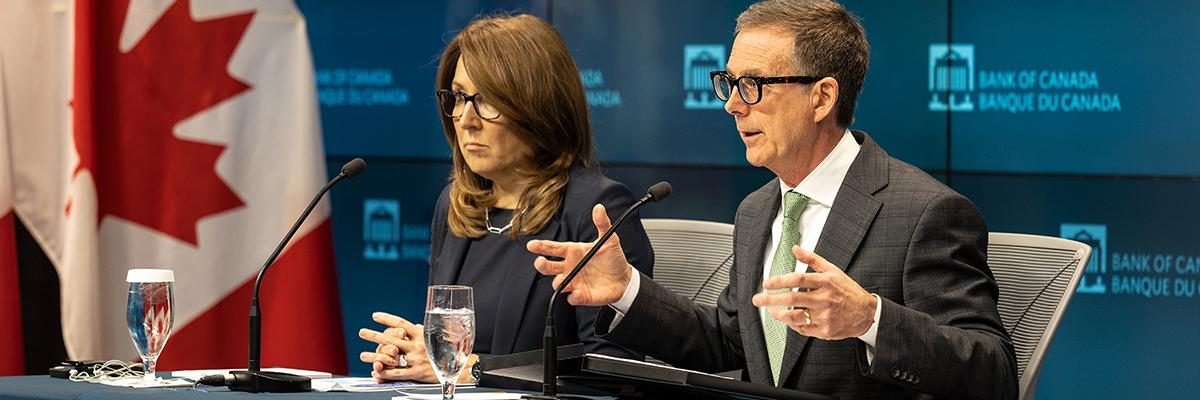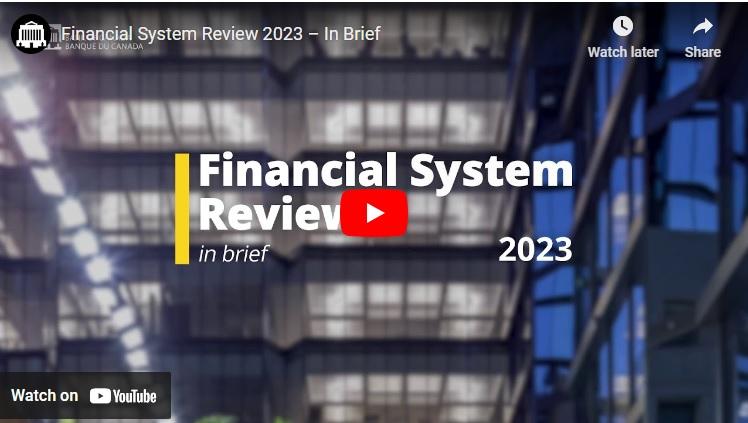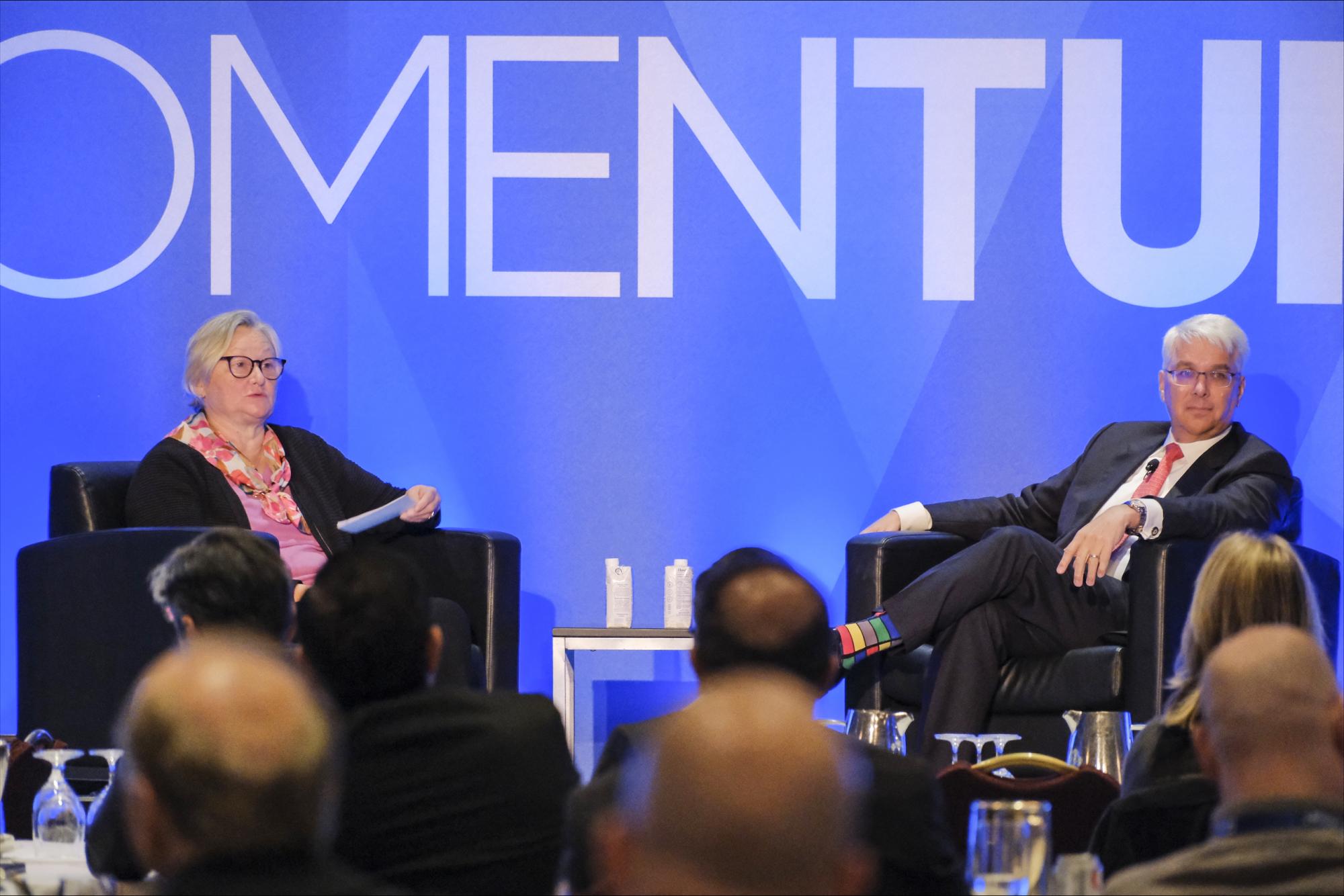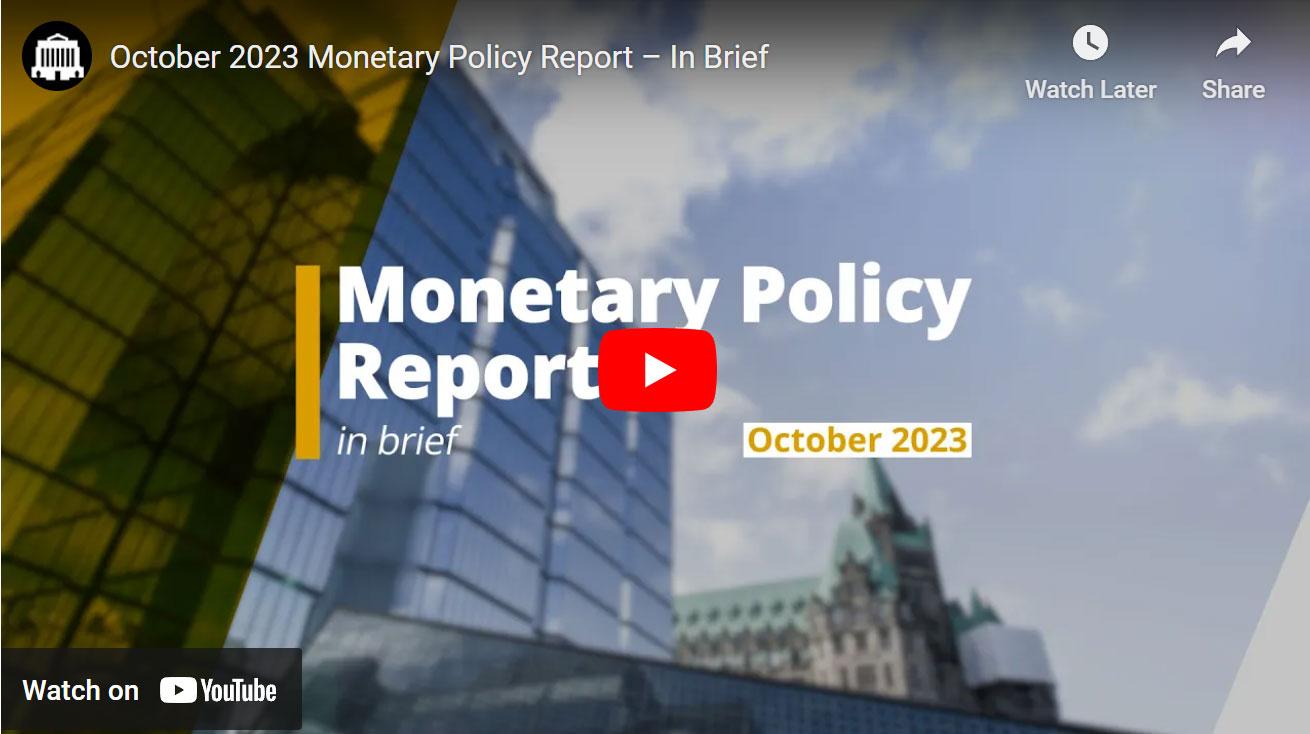
Governor’s foreword
In 2023, the Bank of Canada made considerable progress in the fight against inflation and laid the groundwork for the return to price stability. But even as inflation came down considerably, increases in the cost of living continued to squeeze Canadians. For many, higher interest rates added to their burden. The challenge for the Bank was to set our policy interest rate high enough to wring high inflation out of the economy, but not so high that we stifled it. Global events ranging from foreign bank failures to the war in Israel and Gaza added uncertainty and brought new risks.
Through the year, monetary policy worked to moderate spending, rebalance the economy and relieve price pressures. Inflation came down from a peak of 8.1% in 2022 to 3.4% in December 2023, and we expect inflation to ease further in 2024. At year’s end, the economy was no longer in excess demand. The labour market, which was very overheated in 2022, had come into better balance and the unemployment rate was where it was just before the COVID‑19 pandemic.
The economy saw some volatility in inflation. The consumer price index fell to 2.8% mid-year and then rose to 4% before easing back to 3.4% at the end of 2023. Canadians can expect more pushing and pulling on inflation through 2024, as weak growth relieves price pressures but tightness in some sectors exerts upward pressure on prices. The Bank of Canada will set monetary policy carefully, but we will not waver in our resolve to restore price stability for Canadians.
In 2023, we were reminded that financial instability can strike quickly, and the Bank needs to be prepared to respond. In March, bank failures in the United States and Switzerland shook the global banking system. Strong international banking regulations, combined with swift action by US and Swiss authorities, avoided a wider crisis. Here in Canada, the financial system was stable, with very little spillover from global events. Nonetheless, the global failures were a stark reminder of the importance of fostering a stable financial system, and the Bank monitored the Canadian system closely for early signs of strain. We remain vigilant and have the tools to provide emergency liquidity to the financial system if severe stress were to develop.
The shared resolve to restore price stability and maintain financial stability is anchoring long-run inflation expectations and limiting contagion from financial instability events. The Bank of Canada is a strong voice at the international table on the joint imperatives of staying the course to price stability and fully implementing international standards for banks. However, conflicts and geopolitical tensions are increasing global fragmentation, making it harder to achieve international consensus. This underscores the importance of multilateral institutions in maintaining a well-functioning international monetary system. The Bank of Canada continues to support the International Monetary Fund in its work.
Much of the Bank of Canada’s focus in 2023 was on managing immediate policy imperatives, but we also made important investments in the future. We invested in trust. We need to restore the trust we’ve lost because inflation has been too high for the past two years. We want diverse perspectives. We want to listen to and connect with more Canadians.
To achieve these goals, we strengthened our decision-making processes and improved our transparency and communications:
- We created a new role on Governing Council, and appointed economics professor Nicolas Vincent as an external, non-executive Deputy Governor for a term of two years.
- We began publishing summaries of Governing Council deliberations, providing more insight into the Bank’s monetary policy decisions.
- We provided more plain language summaries and short video clips on social media to explain our outlook for the economy.
- Members of Governing Council have been visiting communities across our vast country to listen to Canadians and learn more about how monetary policy is affecting them.
Beginning in 2024, we will take questions from the media after every scheduled rate announcement—not only those accompanied by a Monetary Policy Report. We want households, businesses and communities to understand the actions we are taking and why we are taking them.
We also invested in the tools and skills needed to operate in a world that is rapidly changing. It increasingly looks as though the world will be more prone to supply disruptions and shifts in economic relationships in the future. Climate change and rising geopolitical tensions will likely create new disruptions and new economic shifts. We are making our economic models more flexible to accommodate sudden shifts in economic conditions. The next generation of these models will analyze data on a more granular level and help us consider alternative risk scenarios.
Our responsibility is to ensure that Canada’s payment systems are prepared for the economy of today and tomorrow, and we invested in our digital future. That means being ready for the possibility that Canadians may want to hold central bank money in a digital form. We took an important step in 2023 by listening to Canadians and reporting back on our consultations on a Digital Canadian Dollar. Almost 90,000 Canadians responded to our public questionnaire. We heard how much they value their privacy and that they place a high value on holding money backed by the central bank.
We also heard clearly that Canadians still want the ability to use physical bank notes. We will continue to provide secure bank notes with features that prevent counterfeiting. With the coronation of a new monarch, His Majesty King Charles III will be featured on Canada’s next $20 bank note. Early preparations are underway to issue this new vertical polymer note, complete with the next generation of security features to protect it from counterfeiters.
The Bank also took steps to fulfill its new mandate to supervise retail payment service providers. In 2023, we:
- conducted outreach to payment service providers to ensure they understand their obligations under the Retail Payment Activities Act
- supported the Department of Finance Canada in developing supervisory policies and guidelines
- launched a website to explain the policies and practices the Bank will use to ensure payment service providers comply with requirements for managing operational risk and safeguarding end-user funds
In a year that saw many changes, some things stayed constant. Our employees remained our greatest strength, and we continue to invest in their well-being. The Bank was named one of Canada’s Top 100 Employers for the 14th consecutive year. Over 80% of our employees said they would recommend the Bank as a great place to work, and 86% said they felt supported by their leaders. We’re proud of that, but we did not stand still. We continued to foster greater equity, diversity and inclusion. We are enhancing our analysis of human resources data to better understand and address the root causes of pay gaps for equity-seeking groups.
The coming year promises to be one of transition. The effects of past interest rate increases will continue to work their way through the economy, restraining spending and limiting growth and employment. This will not feel good. But by the end of 2024, we expect inflation will be closer to our 2% target, growth will be picking up and businesses will be expanding their hiring plans.
We know we need to be ready for new developments. We won’t be able to forecast them all—there are certain to be bumps in the road and new surprises. We should be humble about our forecasts and nimble when required. And, critically, we must learn from the high inflation we’ve experienced recently, so that we can come out of this difficult period better prepared for what lies ahead.
Tiff Macklem
Governor

2023 by the numbers
3.9%
Consumer price index inflation
5.00%
Policy interest rate at year-end
8
Number of Governing Council deliberation summaries published
$119.4
billion—Value of bank notes in circulation as at December 31, 2023
1.0%
Canada’s average annual real gross domestic product growth as estimated at December 31, 2023
75.61
US cents—Exchange rate for Can$1 as at December 31, 2023
$179.8
billion—Nominal value of marketable bonds issued by the Government of Canada in 2023
$281.1
billion—Nominal value of Government of Canada bonds held by the Bank of Canada, a reduction of $88.4 billion since December 31, 2022
7
parts per million (ppm)—Counterfeiting rate in Canada as at December 31, 2023
89,423
Number of Canadians who participated in the Bank’s public consultations on a Digital Canadian Dollar
2,350
Number of employees as at December 31, 2023
14
Consecutive years as one of Canada’s Top 100 Employers
85
Percentage of employees who would recommend the Bank as a great place to work
Social media followers at year-end
2,570
3,601
250,050
X (formerly known as Twitter)
166,774

Mandate and planning framework
Mandate
The Bank of Canada is the nation’s central bank. Its mandate, as defined in the Bank of Canada Act, is “to promote the economic and financial welfare of Canada.” Its vision is to be a leading central bank—dynamic, engaged and trusted—committed to a better Canada.
The Bank has five core functions:
- Monetary policy—to keep inflation low, stable and predictable
- Financial system—to promote safe, sound and efficient financial systems within Canada and internationally
- Currency—to design, issue and distribute Canada’s bank notes
- Funds management—to act as fiscal agent for the Government of Canada, advising on and implementing its public debt and foreign exchange reserve strategies
- Retail payments supervision—to supervise payment service providers, building confidence in the safety and reliability of their services and helping protect users from specific risks
Efficient and innovative operations help the Bank achieve its mandate and business objectives.
Planning framework
A robust planning framework puts the Bank’s vision and mandate into practice. Every three years, the Bank develops a strategic plan to establish its goals, priorities and measures of success.
The strategic plan:
- helps the Bank prepare for and adapt to the realities of its operating environment
- guides annual planning and budgeting activities
- serves as the foundation for employee objectives
In 2023, the Bank completed the second year of its 2022–24 strategic plan, Delivering on Our Promise. The plan and its five overarching themes provide a framework to guide decision-making while leaving room for the flexibility and agility needed in a changing environment.
Reporting
The Bank is committed to:
- publishing information about its operations
- reporting on its financial and non-financial performance during the year
On this page

Monetary policy
Canadian economic growth slowed significantly in 2023 as the effects of interest rate increases continued to work their way through the economy. Although inflation was still above the Bank of Canada’s 2% inflation-control target at the end of the year, monetary policy tightening in Canada and abroad had slowed demand and started to ease price pressures.
Inflation in the consumer price index declined significantly from its June 2022 peak of 8.1% to reach 3.4% by the end of 2023. Despite substantial monetary policy tightening, progress toward the inflation-control target has been slower than anticipated.
The Bank raised its policy rate three times in 2023 for a total increase of 75 basis points. This brought the policy interest rate to 5% by July. From then on, Governing Council kept rates unchanged as it monitored signs that past rate increases were having the desired effects of bringing demand and supply into better balance and easing inflationary pressures.
The Bank used a variety of channels to communicate that it:
- would continue to assess whether the current policy interest rate would be sufficient to achieve the 2% inflation-control target
- was prepared to raise the policy interest rate further should inflationary pressures persist
- was carefully weighing the risks associated with both under- and over-tightening of monetary policy
Throughout 2023, the Bank continued its quantitative tightening (QT) as part of normalizing its balance sheet.
Monitoring inflation in the consumer price index
Over the course of 2023, evidence grew that the Bank’s monetary policy was working. Inflation, which had been at 5.9% in January, fell to 2.8% by June. Although it briefly climbed back up to 4% in autumn, it eased to 3.4% by the end of the year. Despite this progress, inflation remained above the Bank’s target throughout 2023.
Low energy prices drove much of the easing in inflation during the first half of 2023. Inflation in the prices of food and many other goods and services also showed signs of easing, as input costs decreased and demand began to slow. However, shelter price inflation remained high, mostly due to the rising costs of mortgage interest and rent. Overall, progress toward the Bank’s inflation target was slower than expected.
Business and consumer expectations for near-term inflation also continued to ease in 2023, but they remained both higher than before the start of the COVID‑19 pandemic and higher than the Bank’s forecast for inflation. Bank survey results indicated that consumers and businesses expected inflation to be above the 2% target for the next two years. Expectations for longer-term inflation remained consistent with the 2% target. Results also revealed that businesses have continued to increase prices more than usual, indicating that corporate pricing behaviour has yet to normalize.
Implementing monetary policy and managing the Bank’s balance sheet
The Bank, like many of its central bank peers, used a variety of tools to address high inflation and manage its balance sheet. These include increases to its policy interest rate and QT, which began in 2022 and continued through 2023. With QT, the Bank no longer replaces maturing Government of Canada bonds on its balance sheet. As a result, the size of the Bank’s balance sheet continued to decline, from $410.7 billion at the end of 2022 to $316.8 billion at the end of 2023.
As well, the Bank began to assess its operational framework for implementing monetary policy and managing its balance sheet in anticipation of the new steady state. This work involved estimating the ultimate range and day-to-day management of settlement balances and offsetting assets, as well as reviewing the Bank’s tools for market operations and asset acquisition.
This follows the Bank’s 2022 announcement that it would implement monetary policy using a floor system—where the interest rate on the overnight deposit facility is equal to the target for the overnight rate. In 2023, the Bank further explained its rationale for maintaining this system.1 It also provided some estimates for the steady-state range of settlement balances and the expected duration of QT.2
ICYMI: In her speech at the @UofRegina, Deputy Governor Kozicki discusses how and why we consider household differences when making policy decisions.https://t.co/2cUK2HQUI7#cdnecon #economy pic.twitter.com/Xahzn3HSnl
— Bank of Canada (@bankofcanada) September 20, 2023
Rebalancing supply and demand
Gross domestic product grew solidly by 2.6% at the start of the year. However, economic growth stalled through the middle of 2023. The softening in demand was most visible in sectors that are sensitive to interest rates. For example:
- the housing market continued to slow
- consumer spending softened
- per capita consumption fell even though solid population growth continued to support overall spending
With slowing demand growth and rising supply, an increasing number of indicators suggested that the economy was in balance in the second half of the year.
Supporting the Bank’s monetary policy function
Despite the highly complex forces affecting supply and demand, the Bank’s forecasts correctly anticipated that in 2023:
- Canadian and global growth would slow
- inflation would fall significantly from the peaks observed in 2022
| Achievement of target for consumer price index (CPI) inflation | ||||||||
| Key indicators | Reference level | 2017 | 2018 | 2019 | 2020 | 2021 | 2022 | 2023 |
| CPI inflation (%) | 2.0 | 1.6 | 2.3 | 1.9 | 0.7 | 3.4 | 6.8 | 3.9 |
| Average CPI inflation since 2001 (%) | 2.2 | |||||||
| Inflation expectations at a 10-year horizon (%) | 2.0 | 2.0 | 2.0 | 2.0 | 2.0 | 2.0 | 2.0 | 2.0 |
Analyzing inflationary pressures and the transmission of monetary policy
In 2023, the Bank continued its extensive analysis of inflationary pressures. As always, its macroeconomic models were essential in this work. Staff explored, among other topics:
- the supply side of the economy
- the role of structural changes in labour markets and immigration
- input costs and food prices
- supply-chain disruptions and near-shoring3
- the effects of pricing behaviour and markups on inflation4, 5
- the recent challenges faced by central banks in forecasting inflation6
Meanwhile, the Bank’s consumer and business surveys continued to provide key information about Canadians’ evolving expectations for inflation. As well, Bank staff engaged with outside experts on these topics.
The Bank also worked to better understand the effects of higher interest rates. It used its macroeconomic models, as well as detailed Canadian mortgage data, to capture the implications for mortgage interest costs and consumer spending. As well, it enhanced and updated its framework for assessing the health of the Canadian labour market and used microdata to better understand labour market dynamics.7, 8
Inflation dynamics in the rest of the world have been similar to those observed in Canada. Drawing lessons from a range of countries’ experiences, the Bank analyzed the roles that monetary policy, inflation expectations and easing supply constraints play in the process of global disinflation.
Integrating a variety of data points to strengthen analysis
Given the high level of economic uncertainty during 2023, the Bank actively sought out new data and information sources to strengthen its analysis. These efforts included:
- enhancing the Bank’s business and consumer surveys and making use of insights from its Market Participants Survey, the results of which were published for the first time in February 2023 following a successful pilot
- applying innovative approaches to non-traditional data, such as using textual analysis of news reports to track layoffs in real time and aggregating firm-level job postings to monitor vacancies by industry
- reviewing market intelligence practices to ensure the Bank is maximizing its engagement with stakeholders in financial markets
- exploring how valuation ratios in the Canadian stock market can help reveal investors’ expectations about future economic growth
- developing a new analytical model that combines macroeconomic and financial market variables to estimate probabilities of various growth and inflation outcomes
Bank staff also explored research and data related to Indigenous economies in Canada and continued to examine how monetary policy affects them.9 Such analysis gives the Bank a clearer picture of the different ways its actions affect various groups.
Assessing the implications of structural changes to the economy
Staff continue to investigate what structural changes mean to the economy—both in Canada and around the world. Research and analysis on their implications provide another input into the Bank’s decision-making and monetary policy actions.
In 2023, this work included a variety of research on the implications of the surge in population that began in 2022.10 Staff also explored the roles that digitalization, automation and the adoption of advanced technologies play in the Canadian economy. Notably, staff examined the implications of digitalization for labour markets, productivity, prices and monetary policy.
The effects of climate change are also an important driver of structural change. The Bank continued to integrate climate considerations into its research and analysis. This included developing an enhanced and expanded set of modelling tools for assessing the effects of climate change and the transition to a low-carbon economy. The Bank integrated the impact of green investment tax credits into its projection of business investment. In addition, staff analyzed the adverse effects of climate disruptions on international trade.11
Looking forward
In 2024, the Bank will continue to assess how higher interest rates affect inflation and the broader economy. In addition, the Bank will:
- adapt its balance sheet management and market operations to support the anticipated steady state
- continue to improve its macroeconomic models, including the ongoing development of a new suite of models to produce more accurate projections and better enable a risk management approach to monetary policy
- deepen its understanding of inflation drivers, including labour market tightness and wage developments
- enhance its surveys and outreach as well as the tools it uses to understand what structural changes mean for monetary policy and the economy
- publish its Indigenous Reconciliation Action Plan
- initiate a review of its COVID-19 pandemic response
- plan for the 2026 renewal of its monetary policy framework
More information
Framework for market operations and liquidity provision
Canadian Survey of Consumer Expectations
“Ending the pain of high inflation” (remarks by Governor Tiff Macklem)
“Understanding the unusual: How firms set prices during periods of high inflation” (remarks by Deputy Governor Nicolas Vincent)
“Rebalancing the economy while managing risks” (remarks by Deputy Governor Sharon Kozicki)
- 1. T. Gravelle, R. Morrow and J. Witmer, “Reviewing Canada’s Monetary Policy Implementation System: Does the Evolving Environment Support Maintaining a Floor System?” Bank of Canada Staff Working Paper No. 2023-10 (May 2023).[←]
- 2. T. Gravelle, “The Bank of Canada’s market liquidity programs: Lessons from a pandemic” (remarks to the National Bank Financial Services Conference, Montréal, Quebec, March 29, 2023).[←]
- 3. S. Kabaca and K. Tuzcuoglu, “Supply Drivers of US Inflation Since the COVID‑19 Pandemic,” Bank of Canada Staff Working Paper No. 2023-19 (March 2023); O. Kryvtsov, J. C. MacGee and L. Uzeda, “The 2021–22 Surge in Inflation,” Bank of Canada Staff Discussion Paper No. 2023-3 (January 2023).[←]
- 4. R. Asghar, J. Fudurich and J. Voll, “Firms’ inflation expectations and price-setting behaviour in Canada: Evidence from a business survey,” Bank of Canada Staff Analytical Note No. 2023-3 (February 2023).[←]
- 5. P. Bouras, C. Bustamante, X. Guo and J. Short, “The contribution of firm profits to the recent rise in inflation,” Bank of Canada Staff Analytical Note No. 2023-12 (August 2023).[←]
- 6. C. Conces Binder and R. Sekkel, “Central Bank Forecasting: A Survey,” Bank of Canada Staff Working Paper No. 2023-18 (March 2023).[←]
- 7. S. Birinci, F. Karahan, Y. Mercan and K. See, “Labour Market Shocks and Monetary Policy,” Bank of Canada Staff Working Paper No. 2023-52 (October 2023); S. Birinci, Y. Park, T. Pugh and K. See, “Uncovering the Differences Among Displaced Workers: Evidence from Canadian Job Separation Records,” Bank of Canada Staff Working Paper No. 2023-55 (October 2023); L. Shao, F. Sohail and E. Yurdagul, “Labour Supply and Firm Size,” Bank of Canada Staff Working Paper No. 2023-47 (August 2023).[←]
- 8. E. Ens, K. See and C. Luu, “Benchmarks for assessing labour market health: 2023 update,” Bank of Canada Staff Analytical Note No. 2023-7 (May 2023).[←]
- 9. A. Chernoff and C. Cheung, “An Overview of the Indigenous Economy in Canada,” Bank of Canada Staff Discussion Paper No. 2023‑25 (October 2023).[←]
- 10. T. Gravelle, “Economic progress report: Immigration, housing and the outlook for inflation,” (speech to the Windsor–Essex Regional Chamber of Commerce, Windsor, Ontario, December 7, 2023).[←]
- 11. G. R. Dunbar, W. Steingress and B. Tomlin, “Climate Variability and International Trade,” Bank of Canada Staff Working Paper No. 2023‑8 (January 2023).[←]
On this page

Financial system
The Bank of Canada plays an essential role in promoting and preserving the stability and efficiency of the Canadian financial system. This work helps to sustain economic growth and raise standards of living for Canadians.
In 2023, central banks continued to increase policy interest rates in response to high and persistent inflation. These elevated interest rates, while necessary to reduce inflation, tested the resilience of the global financial system.
In March, for example, banking sectors in the United States and Switzerland faced acute stresses. Authorities in those countries reacted swiftly to limit spillover effects. But these events underscored the need for financial system participants to adapt after more than a decade of low interest rates. These events also served as a reminder that risks can emerge and spread quickly, requiring increased vigilance from regulators and central banks.
Senior Deputy Governor Rogers explains in her speech why interest rates may stay higher than Canadians are used to and how, by adjusting early, we can minimize future financial risks.https://t.co/JcVDQPtCFn#cdnecon #FinancialStability @AdvocisVan pic.twitter.com/Mqnwi4WfOV
— Bank of Canada (@bankofcanada) November 9, 2023

https://twitter.com/bankofcanada/status/1722664154631147861
Adjusting to higher interest rates and tightened financial conditions
Global financial conditions have tightened considerably because of monetary policy actions to reduce inflation. The strong response by central banks—including the Bank of Canada—helped to bring inflation down from its June 2022 peak. But it also exposed weaknesses in the global financial system—notably, those inherent in business models relying heavily on both low interest rates and low volatility.
The stresses that appeared in the international banking sector in March 2023 brought these weaknesses to light. In Canada, however, the financial system proved resilient, partly because Canadian banks had only small direct exposures to the troubled American and Swiss institutions. Additionally, Canadian banks are held to the highest global regulatory standards and are subject to rigorous supervision.
Canadian banks—like those around the world—are generally more resilient today than they were before the 2008–09 global financial crisis. Financial institutions have made significant improvements in their financial buffers and risk management practices. Regulators, too, have taken important steps to ensure the Canadian financial system remains robust. However, if global financial stress re-emerges and becomes persistent, the stability of the Canadian financial system could face challenges.
Supporting the Bank’s financial system function
The Bank conducts rigorous research and analysis to inform its efforts to foster a stable and efficient financial system. It also collaborates with federal, provincial and international authorities as well as with industry.
Assessing vulnerabilities and risks
The 2023 Financial System Review (FSR) presented the Bank’s assessment of key vulnerabilities and risks to the financial system. Its theme in 2023 was the adjustment to large increases in interest rates. Throughout the year, the Bank continued to leverage microdata to track how this adjustment was playing out for households and the financial sector. The Bank’s key indicators of financial vulnerabilities suggested that early signs of financial stress had emerged.

https://www.youtube.com/watch?v=OPRcwXLCB3g
From a historical perspective, acute financial stress among Canadian households remained low in 2023. However, a severe recession could affect the ability of households to pay their mortgages, potentially leading to credit losses for lenders.
Additionally, the Bank analyzed the balance sheets of banks and non-bank financial institutions. Staff found that, although these institutions managed well in 2023, risks remain—notably to the cost and availability of funding.
As outlined in the FSR, the Bank continued to track other vulnerabilities and risks, such as those posed by climate change and digitalization. Staff published research and analysis on:
- the financing sources of Canadian organizations that report greenhouse gas emissions
- flood risks and their impact on lending for residential real estate
- climate transition risks and how they affect the financial system
- decentralized finance
Visit the Bank’s Financial System Hub for more information about its work in these areas.
Analyzing the link between monetary policy and financial stability
The financial system plays an important role in transmitting monetary policy. In 2023, the Bank continued to assess how this transmission is occurring in the current interest rate environment. For instance, microdata on mortgage payments helped the Bank understand how much of an effect higher interest rates have had—and are expected to have—on reducing borrowers’ disposable income.12
Considering the implications of financial market activity
As financial markets evolve, the Bank systematically conducts analysis to understand how these developments can affect the Canadian financial system, including its stability. In 2023, Bank staff conducted a variety of work in this area.
For example, staff analyzed the March 2020 trading behaviour in the Government of Canada bond market, at the peak of market turbulence. They found that hedge funds can contribute to one-sided markets and amplify declines in market liquidity.
Another study of the behaviour of market participants found that Canadian life insurers did not face significant draws on liquidity during recent stress periods (such as the COVID‑19 pandemic) and were able to maintain their usual investment activities. In contrast, other types of asset managers saw their liquidity needs increase significantly and therefore likely contributed to market stress during these periods.
Bank staff also found that options markets can provide a gauge of investor risk sentiment during times of stress. A review of the price movements of options on exchange-traded funds suggested that investors did not anticipate an adverse scenario for major Canadian banks or the economy during the global banking turmoil in March 2023.
These studies helped shed light on how different market participants respond during stress episodes.
Promoting financial system resilience
The Bank worked closely with federal and provincial authorities in 2023 to monitor and assess the resilience of Canada’s financial system.
This collaboration included the Bank’s continued leadership of the Heads of Regulatory Agencies Committee and the Systemic Risk Surveillance Committee. Through these federal–provincial forums, the Bank helped improve information sharing on important financial system topics.
The Bank continued to work with industry through the Canadian Fixed-Income Forum (CFIF). Efforts focused on promoting an efficient and robust market for fixed‑income securities for Canada. The Bank also agreed to co-chair the Collateral Infrastructure and Market Practices Advisory Group (CIMPA). This new industry working group will foster operational efficiency in the Canadian markets for securities financing and collateral. The group will also identify areas for potential improvement and implement and promote recommended solutions.
Ensuring a robust interest rate benchmark regime for Canada
The Canadian Alternative Reference Rate Working Group (CARR), which is co-chaired by the Bank, continued its work in 2023 to advance benchmark reform in Canada. It completed the first stage of its two-stage transition plan to move the market away from the Canadian Dollar Offered Rate (CDOR). As of the end of June, market participants had adopted pricing based on the Canadian Overnight Repo Rate Average (CORRA) for almost all new derivative and securities transactions.
To support the second stage of the plan—and since CDOR will no longer be published after June 2024—the Bank worked with CARR members to encourage the loan market to quickly adopt CORRA. The 2023 launch of CARR’s forward-looking one- and three-month term CORRA benchmarks will help this stage of the transition.
In October, CFIF announced its proposed path for winding down the issuing of bankers’ acceptances (BA). This path will ensure the Canadian money market continues to function well. In recent years, BAs have been the second-largest product in Canadian money markets after treasury bills; they will no longer be issued after CDOR disappears.
Overseeing payments and financial market infrastructures
The Bank is responsible for overseeing Canadian financial market infrastructures that have the potential to pose systemic or payment system risks. In October 2023, the Bank designated four payment systems as prominent under the Payment Clearing and Settlement Act:
- Visa Inc.’s VisaNet
- Mastercard International Inc.’s Global Clearing Management System
- Mastercard International Inc.’s Single Message System
- Interac Corp.’s Inter-Member Network
The designation of these systems brings them under formal Bank oversight and requires them to follow the Bank’s risk management standards. This will help ensure the systems remain safe, viable and effective methods of payment for Canadians.
Looking forward
In 2024, the Bank will continue to:
- closely monitor how households, businesses and the financial system adjust to a higher interest rate environment
- use microdata to enrich its understanding of financial vulnerabilities and provide timely updates to Canadians on how these vulnerabilities are evolving
- work closely with domestic and international partners to share information and promote the resilience of Canada’s financial system
- complete benchmark reform to help ensure Canadian markets function well by finalizing and supporting the smooth transition away from CDOR
More information
Global Financial Stability Reports from the International Monetary Fund
- 12. See M. teNyenhuis and A. Su, “The impact of higher interest rates on mortgage payments,” Bank of Canada Staff Analytical Note No. 2023-19 (December 2023).[←]
On this page

Retail payments supervision
Throughout 2023, the Bank of Canada continued preparing for its new mandate to supervise retail payment service providers (PSPs). This mandate is outlined in the Retail Payment Activities Act (RPAA), which received royal assent in 2021.
Continuing to prepare for the Bank’s new mandate
In November, the Government of Canada published the Retail Payment Activities Regulations. They clarify details of the RPAA and outline how PSPs must register with the Bank starting November 1, 2024. The Bank helped the Department of Finance Canada draft the regulations.
At the same time, the Bank continued to build its supervisory program. This work included developing policies and guidelines to help PSPs understand their obligations under the RPAA and its associated regulations.
To prepare PSPs for the registration process, the Bank launched a website to post information and guidance documents, including:
- the Bank’s supervisory framework and policies
- more information on the registration process and regulatory requirements

Executive Director, Supervision Ron Morrow (right) participates in Central 1’s Momentum 2023 Summit in November. He provided an overview of and update on the Bank’s development of a retail payments supervisory framework.
Ensuring operational readiness
The Bank continued to build the operational capacity needed for its new mandate. This included developing:
- policies and processes for registering PSPs, including coordinating the review of applications with the Department of Finance Canada and the Financial Transactions and Reports Analysis Centre of Canada
- policies and practices to assess PSPs’ level of compliance with requirements for:
- managing operational risk
- safeguarding end-user funds
- enforcement tools for promoting compliance
- information technology systems to support public-facing and back-office supervisory services
Engaging with payment service providers and other stakeholders
The Bank widened its outreach activities in 2023. It launched a campaign to raise awareness among the PSPs that will be subject to the new regulations. Notably, it worked to inform PSPs of:
- the requirements they will need to meet
- the Bank’s supervisory role

https://www.instagram.com/p/CzwCTC6M9o7/?img_index=3
Looking forward
In 2024, the Bank will:
- publish policies that clarify key components of its supervisory framework
- engage with PSPs on supervisory guidelines related to:
- managing operational risks
- safeguarding end-user funds
- reporting incidents and significant changes
- test the registration process through a pilot project
- begin receiving registration applications in November
- implement the information technology solution that will support public-facing and back-office services
- raise awareness of the RPAA, its associated regulations and the Bank’s supervisory role
- continue to develop relationships with other financial and payment sector regulators
More information
Moving money with confidence: Canada’s new regime for retail payments supervision (remarks by Ron Morrow, Executive Director, Supervision)
On this page

Funds management
As the fiscal agent and banker for the Government of Canada, the Bank of Canada carried out a variety of activities in 2023. These included:
- administering the government’s domestic cash balances
- conducting debt auctions and bond buyback operations
- managing the assets and liabilities of the Exchange Fund Account (EFA)
The Bank also provided banking, settlement and custodial services for other clients, such as financial market infrastructures and other central banks. At the same time, the Bank managed its own investments and liabilities as part of the ongoing normalization of its balance sheet.
The value of domestic Government of Canada bonds issued in 2023 was $179.8 billion. The total stock of domestic marketable debt was projected to reach $1,390 billion by the end of the 2023–24 fiscal year.
Supporting the Government of Canada’s domestic funding and liquidity needs
Bank staff worked closely with the Department of Finance Canada and consulted with financial market participants to:
- raise stable and low-cost funding for federal programs and services
- maintain a liquid and well-functioning market for Government of Canada securities
Advising the Government of Canada on its debt issuance
The Bank provided advice to the Government of Canada on discontinuing the issuance of bonds in the three-year sector and reallocating bonds to other tenors. This advice was based on findings from staff research and feedback from financial market participants.
The Bank also updated the methodology it uses to set medium-term targets for outstanding debt across different tenors. This will help in assessing the costs and risks associated with the government’s debt strategy.
Reviewing Canada’s prudential liquidity plan
The Bank contributed to a review of the Government of Canada’s prudential liquidity plan by analyzing various sources of liquidity. The Bank assesses the plan every five years to ensure the government can satisfy its payment obligations if normal access to funding markets is temporarily disrupted.
Managing the Exchange Fund Account
The Government of Canada’s reserves of foreign currency are held in the EFA to:
- promote orderly conditions in the Canadian-dollar foreign exchange market
- provide a source of liquidity for the Government of Canada
During the 2022–23 fiscal year, the Bank managed the growth of the EFA to about US$82 billion from US$75.5 billion, an increase of US$6.5 billion. Over the remainder of 2023, the Bank worked to grow the EFA to the target value of US$87.5 billion for 2023–24. Overall, about two‑thirds of the reserves were invested in US‑dollar assets, with the balance held in euros, British pounds sterling and Japanese yen.
The Bank also raised funds through short-term US-dollar securities and medium-term cross-currency swaps. These involved exchanging Canadian dollars for foreign currency to acquire liquid reserves.
In April, the Bank led the issuance of a five-year US$4 billion global bond, which was the largest issue size ever from Canada in foreign currency. Demand for the bond was very strong, as evidenced by:
- the large number of orders
- the quality of investors
- the tightening of pricing during execution
Managing Canada’s reserves in a world of reduced liquidity
The Bank also started to evaluate and improve liquidity in the EFA to guard against potential crises. This work has become increasingly necessary since the start of the COVID-19 pandemic because general market liquidity has declined—including liquidity from US government securities—while global macroeconomic and financial uncertainty remain elevated. This has prompted global reserve managers like the Bank to increase their focus on maintaining enough liquidity in their portfolios. Such liquidity may be required to intervene directly in foreign exchange markets to counter disruptive movements.

https://www.instagram.com/p/Cs9D6LLMerU/?img_index=1
Modernizing collateral management
In 2023, the Bank implemented the first release of a system that will enable seamless, flexible and resilient management of collateral through the full trade cycle—from initiation to settlement to reporting. This was a key milestone in the redesign of the technologies and processes that support the Bank’s domestic market operations and Canada’s payment systems.
The new system will improve:
- the efficiency and robustness of the Bank’s repurchase and securities lending operations
- the Bank’s ability to adjust or introduce liquidity operations in response to market stress
Repatriating retail debt operations
In 2023, the Bank repatriated operations for the Government of Canada’s Retail Debt Program. The Bank now services and redeems the government’s outstanding retail debt—roughly $452 million in Canada Savings Bonds and Canada Premium Bonds. These operations had been outsourced since 2001.
Looking forward
In 2024, the Bank will continue to:
- provide advice to the federal government on managing debt, reserves and liquidity
- build on technology and process improvements that support the Bank’s domestic market operations and Canada’s payment systems
On this page

Currency
In 2023, the Bank of Canada continued to:
- provide Canadians with secure bank notes
- monitor the payment preferences of Canadians
- research the future of cash
The Bank also conducted research to better understand and reduce the environmental impacts caused by producing and distributing bank notes. At the same time, the Bank began work on a new design for the $20 bank note, and staff continued to explore the possibility of a Digital Canadian Dollar.
Meeting the demand for cash with bank notes Canadians can trust
The Bank continued to supply financial institutions with bank notes to meet the demand for cash. Roughly 3 billion bank notes were in circulation in 2023.
Surveying Canadians about cash use
The Bank regularly surveys consumers and businesses to better understand how and why they use cash. This information helps the Bank assess Canadians’ awareness of, attitudes toward and behaviours around bank notes.
The results of the Bank’s 2022 Methods-of-Payment Survey show that many Canadians still use cash and that 80% of consumers have no plans to go cashless.
Meanwhile, cash acceptance remains almost universal across businesses in Canada. Results from the 2023 Merchant Acceptance Survey reveal that 96% of small and medium-sized businesses accept cash.
The Bank conducts the Bank Note Confidence Survey twice a year to assess public confidence in the authenticity of bank notes. In 2023, roughly 96% of Canadians expressed confidence that the bank notes they use are real. This aligns with a low counterfeiting rate of 7 parts per million (ppm)—well below the Bank’s benchmark of 30 ppm.
Informing decisions through research
The Bank conducted research to better understand:
- the use, availability and acceptance of cash in Canada as well as trends in payment preferences
- changes in the regulatory landscape for national and international cash systems
- the ownership of digital currencies and cryptoassets in Canada as well as the implications of fintech innovations for financial stability
- the policy, economic and technical implications of a Digital Canadian Dollar, including its potential effects on private banks
- the latest innovations in bank note security features to guard against counterfeiting
- options to make the life cycle of a bank note more environmentally sustainable
Exploring a Digital Canadian Dollar
Through policy, economic and technical research, the Bank continued to explore the possibility of a digital form of the Canadian dollar. This potential form of money would:
- be issued by the Bank
- provide benefits similar to those provided by cash—in other words, it would be:
- safe
- universally accessible
- private
As part of its ongoing consultation on a potential Digital Canadian Dollar, the Bank invited Canadians to participate in a survey to share their views and perspectives. The survey focused on what features would matter most to Canadians if Parliament and the Government of Canada were to decide that a digital form of the Canadian dollar is needed. The consultation generated almost 90,000 responses.
In November, the Bank published a report summarizing key takeaways from its outreach activities on this topic over the past two years.
Designing the next $20 bank note
On May 6, 2023, the day of King Charles III’s coronation, the Office of the Prime Minister of Canada announced that a portrait of His Majesty would be featured on Canada’s next $20 bank note. The Bank initiated the design process for the new note, which will feature a significant step up in security, have a vertical design and be made of polymer.
Greening Canada’s bank notes
The Bank launched a project to identify opportunities for reducing greenhouse gas emissions, water consumption and waste from producing, distributing and recycling bank notes. This work aligns with the Bank’s climate change strategy as well as with the Government of Canada’s plan to reduce greenhouse gas emissions.
Looking forward
In 2024, the Bank will continue to:
- research the use, availability and acceptance of cash in Canada as well as trends in payment preferences
- investigate trends and changes in the regulatory landscape for national and international cash systems
- engage with financial institutions, the broader cash industry and others who play a role in cash system infrastructure to prepare for the future of cash
- conduct policy research and analysis to inform planning for any future Digital Canadian Dollar, including technical design work and monitoring of the payments landscape
- work on the next $20 bank note
More information
Cryptoasset Ownership and Use in Canada: An Update for 2022
On this page

Managing the Bank
The Bank of Canada is made up of a diverse group of engaged employees who work together to achieve the Bank’s business objectives and fulfill its mandate. Their efforts are supported by operations that are constantly evolving, particularly in the areas of efficiency, flexibility and resilience.
In 2023, the Bank remained focused on continuous improvement in all these areas. This included enhancing its work environment, modernizing its systems, managing cyber security risk, enabling data innovation and implementing changes to support its sustainability goals.
Remaining a top employer
The Bank was again recognized as one of the best places to work in Canada. For the 14th consecutive year, it was named one of Canada’s Top 100 Employers. The Bank was also recognized as a diverse, inclusive and family-friendly place to work.

https://www.linkedin.com/posts/bank-of-canada_life-the-bank-activity-7127736628306931712-sJwg/
Supporting an engaged workforce
In April, the Bank conducted its Work Environment Check-Up survey, which employees are invited to complete every three years. This was the first in-depth employee engagement survey since before the COVID‑19 pandemic. Results were positive, particularly the feedback employees provided on their immediate leaders. As always, the results also highlighted areas where employees believed the Bank could make improvements.
Building a more flexible and supportive work environment
The Bank continued to focus on being an attractive employer by:
- confirming its hybrid work model early in the year—this enabled employees to settle into new routines for coming to work on site
- continuing to offer flexible work arrangements that help employees achieve greater work-life balance—this has helped with recruiting in a challenging labour market
- providing leaders and employees with opportunities for training and development that support career advancement and continuous learning
Fostering greater diversity and inclusion
The Bank advanced its equity, diversity and inclusion goals in a variety of ways. In 2023, it:
- completed actions from its three-year accessibility plan, including incorporating accessibility considerations into procurement processes
- engaged with Indigenous employees to develop the Bank’s Indigenous Reconciliation Action Plan
- enhanced the analysis of internal data on human resources—this included conducting a review of the Bank’s compensation framework to assess its alignment with new requirements under federal pay equity legislation

Bank staff participate in Ottawa’s Capital Pride Parade.

Chief Operating Officer Filipe Dinis takes part in Canada’s National Remembrance Day Ceremony at the National War Memorial in Ottawa.
Enhancing the Bank’s systems and tools
The Bank continued to reinforce the systems, tools and processes used in its critical operations. A particular focus was ensuring the Bank could maintain its critical operations during a disruption. To this end, the Bank:
- completed simulation exercises to evaluate its ability to recover from and continue operating after a disaster
- migrated high-priority infrastructure and applications to the cloud and to resilient on-site systems to increase flexibility and reliability
- updated the technology and equipment in its currency distribution centres
- automated processes and implemented additional self-service capabilities for employees
These enhancements further strengthened the foundation of secure, reliable systems that enable the Bank to fulfill its mandate.
Reinforcing cyber security inside and outside the Bank
Given the rapidly changing cyber landscape, the Bank continuously enhances its capacity to manage cyber security risks. In 2023, the Bank improved the processes for verifying and authenticating system activity across its platforms. It also further strengthened its detection controls, credential management and approach to mitigating third-party cyber risk.
The Bank continued to work closely with partners in the Canadian financial sector and around the world to promote the resilience of Canada’s financial system to cyber security risks.
Leveraging data and analytics
The Bank’s information needs are always evolving. Because of this, the Bank frequently brings in new types of data and analytics to strengthen its research, analysis and operations. Its focus in 2023 was on continuing to expand data capabilities and to integrate diverse information sources and analysis techniques.
The Bank also continued to explore potential ways to use artificial intelligence (AI) such as large language models. It remained committed to ensuring responsible employee use of AI tools. To that end, it implemented internal guidelines and best practices and began developing a responsible AI framework that will set standards related to governance and reporting. While these tools are not yet widely used by employees, this work is helping to ensure the Bank can begin to benefit from these technologies while reducing the potential risks.
The Bank worked closely with domestic and international partners on issues related to artificial intelligence and quantum computing. Notably, it collaborated with other members of the Canadian Forum for Digital Infrastructure Resilience to develop guidelines for quantum readiness.13 These guidelines establish best practices that stakeholders in the Canadian critical infrastructure sector and others can use to protect themselves against potential threats posed by this powerful technology.
The Bank also continues to offer training to ensure that employees have the depth and breadth of knowledge required to leverage new analytical tools and novel forms of data.
Meeting our commitments to greener operations
In 2023, the Bank prepared its second annual report disclosing its climate-related risks. This reporting follows the recommendations of the Financial Stability Board’s Task Force on Climate-related Financial Disclosures. It also aligns the Bank with the more than 1,400 public organizations around the world that have published their own disclosures.
The report outlines how the Bank continued to address climate-related risk to its own operations and made progress on its climate commitments. Notably, the Bank surpassed its goal of reducing by 40% the greenhouse gases (GHGs) emitted from its buildings, doing so more than a year before the target date of 2025. The Bank has a longer-term goal of achieving net-zero GHG emissions by 2050.
For the first time, the Bank disclosed in its report the GHG emissions from its bank note supply chain and from the private assets portion of its pension fund. It also disclosed its operational water consumption. Including these new metrics shows the progress the Bank has made in tracking and reporting complex information about its environmental footprint.

https://www.instagram.com/p/CtHOpgcso8T/
Looking forward
In 2024, the Bank will:
- continue to develop and empower its leaders, who play a key role in reinforcing a workplace culture that sets the Bank apart as an employer
- ensure its compensation framework is aligned with federal pay equity legislation
- reinforce its resilience through key technology upgrades and replacements
- strengthen its cyber security posture by enhancing cyber architecture, monitoring and awareness
- continue to enable the use of new data and analytics across the organization
- continue to work toward its environmental sustainability objectives, including the ongoing monitoring of evolving financial reporting standards for climate-related disclosures, and further refinement and publication of its report on climate-related risks
More information
Bringing Our Values to Life: Equity, Diversity and Inclusion Strategy 2022–24
- 13. Quantum-Readiness Working Group of the Canadian Forum for Digital Infrastructure Resilience, Canadian National Quantum-Readiness: Best practices and guidelines (June 2023).[←]
On this page

Communications and outreach
High inflation and rising interest rates continued to challenge Canadians in 2023. This made transparent communications and engagement more important than ever. The Bank of Canada increased its efforts in both areas.
To give Canadians a better understanding of how interest rate decisions are made, the Bank began publishing a summary of Governing Council deliberations after each interest rate announcement. It also expanded its social media presence to reach more Canadians, joining Facebook and Instagram and posting about a wider range of topics than before.
The Bank continued to engage with individuals and stakeholders in key areas. Meanwhile, the Bank of Canada Museum increased its educational content for in-person visitors and on its website.
Building trust through transparency and engagement
Launching a publication that sheds light on the Bank’s decision-making process
The summary of deliberations published after each interest rate announcement contains more information than in the announcement press release. The summary explains:
- what issues Governing Council considered in its deliberations
- how Governing Council interpreted economic developments
- how Governing Council reached consensus on its decision
By being more transparent about Governing Council’s discussions, the Bank aims to increase Canadians’ awareness of and confidence in the decision-making process. This, in turn, makes monetary policy more effective because businesses and households can make informed decisions about spending and saving.
Adopting additional tools and expanding the Bank’s social media content
The Bank launched Facebook and Instagram accounts in both official languages. This move was motivated in part by the Bank’s desire to reach a wide variety of audiences, such as young people. This gives it a presence on two additional social media platforms that are commonly used by Canadians.
While the Bank has been active on social media since 2008, its messages had focused mainly on key publications and events. In 2023, the Bank began to post on a broader range of topics, such as:
- educational content about economic concepts
- the Bank’s history and mandate, including its new retail payments supervision function
- its research work as well as the financial and data tools it offers on its website
- bank notes and tips for spotting counterfeits
- job opportunities and what it’s like to work at the Bank
This diverse content provides Canadians with a more comprehensive view of the many ways the Bank serves them. It also offers insight into the Bank’s core values and dedicated staff.
Engaging with stakeholders and informing Canadians
The Bank reached out to Canadians about several topics:
- the economic environment and the effects of interest rate decisions on different sectors and regions
- the implementation of its retail payments supervision responsibilities
- its Indigenous Reconciliation Action Plan
- a potential Digital Canadian Dollar
Conducting outreach with the Canadian business community
As interest rate increases worked their way through the economy in 2023, Governing Council members held outreach events with business leaders from various sectors across Canada. Through these sessions, the Bank learned about the perspectives of business leaders who make decisions that affect Canada’s economy.
Raising awareness among payment service providers of the Bank’s new mandate
The Bank launched a campaign to raise awareness among the payment service providers (PSPs) that will be subject to new regulations under the Retail Payment Activities Act. The campaign included engaging with PSPs and publishing a newsletter.
Taking steps toward economic reconciliation with Indigenous Peoples
The Bank advanced work on its Indigenous Reconciliation Action Plan. This involved:
- engaging with Indigenous organizations and publishing a report on what it heard
- developing a draft action plan and inviting feedback from Indigenous partners and communities
The Bank also continued to be an active participant in the Central Bank Network for Indigenous Inclusion. It participated in the Symposium on Indigenous Inclusion hosted by the Reserve Bank of New Zealand. The 2023 event covered topics such as financial inclusion and access to capital.
For the first time since the onset of the COVID‑19 pandemic, the Bank hosted an in-person meeting of the Indigenous Advisory Circle. The meeting brought together cultural Knowledge Keepers from different First Nations, Inuit and Métis communities.
Consulting the public on a Digital Canadian Dollar
The Bank continued its outreach on a potential Digital Canadian Dollar. As part of this work, it invited Canadians to take part in a survey to share their views and perspectives. In November, the Bank published a report summarizing key takeaways from its outreach activities on this topic over the past two years.
Expanding the Bank of Canada Museum’s educational content
The Bank of Canada Museum continued to play a crucial role in raising awareness about the economy and the Bank’s work. In 2023, it:
- offered on-site and virtual school programs to 7,948 students
- provided teachers with a variety of educational resources geared toward students from grades 4 to 12, including the first two themes of its “You Are the Economy” resource
- launched an exhibition called “Money in 10 Questions: Kids Edition,” for which it solicited questions from children across the country and received more than 800 submissions
- issued its second Award for Excellence in Teaching Economics, this year to teachers from Saskatchewan and Manitoba
- continued to implement its accessibility plan, including wayfinding and special programs for children on the autism spectrum
Looking forward
In 2024, the Bank will continue to improve how it communicates with Canadians. It will:
- begin holding a press conference after each monetary policy decision to help households, businesses and communities understand the actions it is taking and why
- expand its outreach activities across Canada, enabling Governing Council members to hear directly and more often from individuals and stakeholders
- publish a fully digital version of its flagship publication, the Monetary Policy Report—the new format will enable readers to interact with data and find information more easily
- publish and implement its Indigenous Reconciliation Action Plan
- raise awareness of the economy and the Bank’s work by broadening the Museum’s educational programs
On this page

Global engagement
The Bank of Canada and its international counterparts faced important policy challenges in 2023. Most notably:
- Inflation remained too high in many countries, and the persistence of underlying inflation suggested that global interest rates may need to be higher for longer. This increases the risk of financial stability challenges ahead.
- The global economy and financial system were adjusting to the higher interest rates needed to combat inflation. This raised concerns about hidden risks, such as the stresses in the banking sector that emerged in March 2023.
Meanwhile, Russia’s war against Ukraine continued, and conflict in the Middle East reignited. Broader geopolitical tensions were heightened, and signs of geo-economic fragmentation increased.
Combined with structural forces such as climate change, the potential lasting effects of these challenges suggested that economies needed to prepare for more volatility and more frequent supply shocks.
Against this backdrop, the Bank used its influence to emphasize several points:
- Central banks must continue their efforts to bring inflation back to target—otherwise, existing challenges will be amplified.
- Central banks have the tools to help fight inflation and maintain the stability and resilience of the global financial system.
- Monetary, fiscal, structural and trade policies must work in the same direction and not at cross-purposes.
- Effective and legitimate multilateral institutions are essential to the sound functioning of the international monetary and financial system.
Exchanging information to combat high inflation
Governor Macklem and other central bank governors discussed inflation through such forums as the Bank for International Settlements, the International Monetary Fund (IMF), the G7 and the G20.
Overall, central bank governors agreed that higher interest rates were having the desired effect of helping rebalance demand and supply and ease inflationary pressures. They also noted that inflation was coming down without provoking recessions or large increases in unemployment. But many shared the concern that core inflation was persistently high and that this was preventing inflation from returning to targets.
The Bank engaged with its international counterparts to help identify and disentangle the common global forces that are affecting the evolution of inflation in their respective countries. This allowed central banks to craft policies that more fully integrate the risks to inflation from global factors.
In their joint communications to the public, such as G7 and G20 communiqués, Governor Macklem and his international counterparts reaffirmed their shared commitment to restoring price stability.

Governor Tiff Macklem (right) at the Annual Meetings of the Boards of Governors of the World Bank and the International Monetary Fund in Marrakesh, Morocco in October.
Evolving the international monetary and financial system
The Bank continued to advocate for changes to the international monetary and financial system, building on the vision Governor Macklem had set out in a 2021 speech. The need to make the system more resilient, agile and inclusive, with open trade and investment, became even more pressing in 2023.
In this context, the Bank used its annual economic conference to bring together academics and policy-makers to chart a way forward for the international monetary and financial system. The conference looked at how institutions can use policy to navigate a global environment that is more prone to shocks than in the past. Some key takeaways from the discussions:
- The international monetary and financial system has been resilient so far but will continue to be tested.
- The system needs to adapt to ensure it has more buffers, or that buffers are better allocated and more efficient.
- A resilient global financial safety net requires a strong IMF.
Promoting resilience across borders
The resilience of the global economy and financial system remained a key area for collaboration in 2023.
Responding to climate change and global supply chain challenges
Under Japan’s G7 presidency, the Bank of Canada and its G7 central bank counterparts committed to better understanding both the near- and the long-term macroeconomic implications of climate change, including those for monetary policy. These include:
- the impacts of different policies to mitigate climate change
- any cross-border or spillover effects that might arise due to countries’ different objectives and approaches to addressing climate change
The Bank advocated strongly that central banks’ core mandates of price and financial stability are important prerequisites for an orderly transition to net-zero greenhouse gas emissions.
The G7 Finance Ministers and Central Bank Governors also discussed how to build resilience into global supply chains. They considered:
- lessons from the COVID-19 pandemic and Russia’s war against Ukraine
- potential bottlenecks that could occur as companies around the world work to develop the green supply chains needed to support a successful climate transition
The Japanese G7 presidency launched the Partnership for Resilient and Inclusive Supply-chain Enhancement to help emerging market and developing economies increase manufacturing of clean-energy products and boost their participation in the minerals industry.
Regulating cryptoassets for a more resilient financial system
The Bank helped the Indian G20 presidency reach consensus on an important roadmap for regulating cryptoassets. The IMF and the Financial Stability Board (FSB) collaborated on this work, integrating macroeconomic and regulatory perspectives while considering the risks specific to emerging market and developing economies.14
The Bank was an active participant in multiple FSB working groups focused on cryptoassets. In addition to its other contributions, the Bank helped shape the FSB’s high-level recommendations for the regulation, supervision and oversight of both cryptoasset activities and markets and global stablecoin arrangements.15, 16
In 2023, Governor Macklem’s term as co-chair of the FSB Regional Consultative Group for the Americas was extended. This forum facilitates dialogue between members and non-members of the FSB. It also plays an important role in promoting the adoption of FSB recommendations among non-members, reducing the potential for regulatory arbitrage.
Supporting funding markets through financial stress episodes
During the episodes of stress in the Swiss and US banking sectors in March 2023, the Bank of Canada and five other major central banks announced a coordinated action to improve the provision of liquidity in global funding markets through swap lines.17 Swap lines between central banks are standing facilities that serve as an important backstop to the global financial system during periods of acute market stress.
Facilitating cross-border payments
Working closely with colleagues at the FSB and other international organizations, the Bank continued efforts to make cross-border payments cheaper, faster, more inclusive and more transparent than they are currently.
After the G20 roadmap on cross-border payments was published in 2020, the international community’s focus shifted to its implementation. This requires close collaboration between the public and private sectors. In 2023, the FSB created a new task force focused on legal, regulatory and supervisory matters. The Bank’s Senior Deputy Governor Carolyn Rogers chairs this task force, which is charged with facilitating dialogue with private-sector entities.
Looking forward
In 2024, the Bank will:
- work closely with its Italian counterpart to support Italy’s 2024 G7 presidency and ensure a smooth transition to Canada’s G7 presidency in 2025
- continue to work with its international counterparts to assess the current and future risks to global growth and the evolution of global factors behind inflation
- strengthen partnerships to deepen the Bank’s understanding of how Canadian and global economies are affected by climate change and how central banks can deliver on their core mandates through the transition to net-zero carbon emissions
- support international efforts to strengthen the prudential regulation of banks and push for coherent international policy frameworks for digital assets and payments
More information
No two ways about it: Why the Bank is committed to getting back to 2% (remarks by former Deputy Governor Paul Beaudry)
The International Monetary and Financial System: Current and Future Challenges (John Kuszczak Memorial Lecture by Pierre-Olivier Gourinchas at the Bank of Canada Annual Conference, introduced by Deputy Governor Sharon Kozicki)
Communiqué from the G7 Finance Ministers and Central Bank Governors Meeting, Niigata, Japan, May 2023
Communiqué from the Fourth G20 Finance Ministers and Central Bank Governors Meeting, Marrakesh, Morocco, October 2023
- 14. International Monetary Fund and Financial Stability Board, “IMF-FSB Synthesis Paper: Policies for Crypto Assets” (September 2023).[←]
- 15. Financial Stability Board, “FSB finalises global regulatory framework for crypto-asset activities” (July 2023).[←]
- 16. Financial Stability Board, “High-level Recommendations for the Regulation, Supervision and Oversight of Global Stablecoin Arrangements: Final Report” (July 2023).[←]
- 17. See Bank of Canada, “Coordinated Central Bank Action to Enhance the Provision of U.S. Dollar Liquidity” (press announcement, March 19, 2023).[←]
On this page

Governance
The Bank of Canada Act provides the legal authority and framework for governance of the Bank of Canada.
Board of Directors
The Bank’s Board of Directors is composed of:
- the Governor
- the Senior Deputy Governor
- a maximum of 12 independent directors
- the Deputy Minister of Finance (who is an ex officio, non-voting member)
Pursuant to the Bank of Canada Act, the Governor is both:
- Chief Executive Officer of the Bank
- Chair of its Board of Directors
As Chair, the Governor leads the Board’s oversight of corporate, financial and administrative matters, including strategic planning, finance and accounting, risk management, human resources and other internal policies. Monetary policy is neither formulated nor implemented by the Board. However, directors regularly provide insight on prevailing economic conditions in their respective regions and sectors.
All independent (non-management) directors are appointed for a three-year renewable term by the Minister of Finance with the approval of the Governor in Council. In 2023, four individuals joined the Board of Directors:
- David Dominy, Ernie Daniels and Shelley Williams were appointed in January.
- Carlos Leitão was appointed in May.
The independent directors elect a lead director for a two-year renewable term. The lead director provides leadership to improve the Board’s effectiveness and acts as a key point of contact with the Governor.18 Claire M. C. Kennedy was reconfirmed as lead director in 2022 and continued in this role in 2023.
The Bank of Canada Act and the Conflict of Interest Act specify eligibility requirements for members of the Board and outline rules to prevent conflicts of interest.
The Board also requires its independent directors to follow the Bank’s Code of Business Conduct and Ethics for Directors.
See the 2023 Board of Directors.
Committee structure and meetings
The Board of Directors has five standing committees, each of which has terms of reference and an annual work plan to guide its activities. The Bank of Canada Act also provides for an Executive Committee that is accountable to the Board and that can act in place of the Board. Each standing committee of the Board, except the Pension Committee, consists solely of independent directors.
Bank of Canada management
Governor and Senior Deputy Governor
The independent members of the Board of Directors appoint the Governor and Senior Deputy Governor for a seven-year term, with the approval of the Governor in Council. The length of this term allows the Governor and Senior Deputy Governor to adopt a long-term perspective. This is essential to the Bank’s effectiveness in conducting monetary policy and performing its other core functions.
The salaries of the Governor and Senior Deputy Governor are within ranges established by the Government of Canada’s Advisory Committee on Senior Level Retention and Compensation. All elements of their total compensation are determined by the Board, subject to the approval of the Governor in Council (the Cabinet). As stipulated in section 6(3) of the Bank of Canada Act, their salaries may not include any element in the form of a commission or that is computed by reference to the income or profits of the Bank.
Governing Council
Pursuant to the Bank of Canada Act, the Governor:
- has specific authority and responsibility for the business of the Bank
- oversees the Bank’s core functions with assistance from the Senior Deputy Governor and the Deputy Governors
The Governor, Senior Deputy Governor and Deputy Governors constitute the Bank’s Governing Council. This policy-making body is responsible for decisions about monetary policy and financial system stability.
Two internal committees are in place to provide advice:
- The Monetary Policy Review Committee assesses economic conditions in Canada and provides advice to Governing Council on monetary policy.
- The Financial System Review Committee is the main forum for presenting and discussing issues related to the financial system.
Three changes to the composition of the Bank’s Governing Council took place in 2023:
- In January, Nicolas Vincent was appointed to the newly created role of external, non-executive Deputy Governor for a term of two years, effective March 13.
- In April, Deputy Governor Paul Beaudry announced he would leave the Bank at the end of July.
- In May, Rhys R. Mendes was appointed to the role of Deputy Governor, effective July 17.

https://www.instagram.com/p/Cvcro_WuTW-/
Bank of Canada management structure
Executive Council is responsible for helping the Governor oversee the Bank’s strategic direction. It is composed of Governing Council (excluding the external, non-executive Deputy Governor), the Chief Operating Officer (COO) and the Executive Director, Supervision.
As members of Executive Council:
- the COO oversees strategic and operational planning, administration and operations
- the Executive Director, Supervision is responsible for the supervision of retail payment service providers and the oversight of financial market infrastructures
In October, the Bank announced that Nick Leswick would be joining Executive Council in the newly created role of Executive Director of Policy (effective January 2024).
The Senior Management Council is composed of both standing and rotating committee members. It supports the work of Executive Council by overseeing:
- operational issues
- corporate programs
- strategic initiatives
- financial reporting
- annual planning
- risk management

From left: Chief Operating Officer Filipe Dinis; Executive Director, Supervision, Ron Morrow; external, non-executive Deputy Governor Nicolas Vincent; Senior Deputy Governor Carolyn Rogers; Deputy Governor Toni Gravelle; Governor Tiff Macklem; Deputy Governor Sharon Kozicki; and Deputy Governor Rhys Mendes.
Compliance and ethics
The Bank requires all employees to observe the highest standards of professional ethics. To this end, the Bank’s comprehensive Code of Business Conduct and Ethics is in place to address the personal and professional conduct of Bank employees. The policy on disclosure of wrongdoing provides information to employees on how to report wrongdoing and outlines management’s role in disclosures, investigations and reporting.
The Board reviews the Code of Business Conduct and Ethics annually.
More information
Code of Business Conduct and Ethics
- 18. See Bank of Canada, “Lead Director: Terms of Reference” (December 2022) for more information.[←]
On this page

Financial results
Overview
This section provides the key highlights of the Bank of Canada’s financial results for the year ended December 31, 2023. These highlights should be read with the financial statements and accompanying notes for the year ended December 31, 2023. Management is responsible for the information presented in the Annual Report.
Since the onset of the COVID‑19 pandemic, the Bank has used extraordinary measures to restore the proper functioning of financial markets and support the economic recovery. In response to high inflation following the reopening of the Canadian economy, the Bank rapidly raised its policy rate and undertook quantitative tightening, in which maturing bond holdings are not being replaced. Refer to the Bank’s website for more information on these measures, including the relevant press releases and market notices.
Managing the balance sheet
| Financial position (in millions of Canadian dollars) |
||
|---|---|---|
| As at December 31 | 2023 | 2022 |
Assets
|
|
| |
| Loans and receivables | 6 | 5 |
| Investments | 292,341 | 378,206 |
| Derivatives—indemnity agreements with the Government of Canada | 23,406 | 31,346 |
| All other assets* | 1,023 | 1,153 |
| Total assets | 316,776 | 410,710 |
| Liabilities and deficiency | ||
| Bank notes in circulation | 119,430 | 119,726 |
| Deposits | 196,212 | 273,333 |
| Securities sold under repurchase agreements | 6,638 | 17,396 |
| Other liabilities | 342 | 352 |
| Deficiency | (5,846) | (97) |
| Total liabilities and deficiency | 316,776 | 410,710 |
* All other assets includes Cash and foreign deposits, Capital assets and Other assets.
The Bank’s holdings of financial assets stem from its unique role as the exclusive issuer of Canadian bank notes and its activities related to monetary policy and the financial system. The value of the assets on the Bank’s balance sheet has declined due to the Bank’s quantitative tightening measures, as a result of improved market conditions and economic performance. The Bank’s total assets decreased by 23% during the year to $316,776 million as at December 31, 2023. The main driver of this decrease was the maturity of investments.
Investments decreased by 23% to $292,341 million as at December 31, 2023. This decrease was driven mainly by the following movements within the Bank’s holdings:
- Government of Canada securities, which include nominal bonds and real return bonds, decreased by $72,051 million during 2023. This decline is mainly due to the bonds maturing. This resulted in a decline of $47,914 million in Government of Canada bonds held at fair value and a decline of $24,137 million in Government of Canada bonds held at amortized cost.
- The Bank engages in repo operations, which provide market participants with a temporary source of Government of Canada securities on an overnight basis. These operations also improve the availability of the Bank’s holdings of Government of Canada securities. The volume of securities repo operations declined during 2023, resulting in a decrease of $11,759 million in securities lent or sold under repurchase agreements, compared with December 31, 2022.
Derivatives—indemnity agreements with the Government of Canada refers to the indemnity agreements that were put in place to indemnify the Bank and allow it to support Government of Canada, provincial and corporate bond markets. Losses resulting from the sale of assets within the Government of Canada Bond Purchase Program, the Provincial Bond Purchase Program and the Corporate Bond Purchase Program are indemnified by the Government of Canada, whereas gains on disposal are remitted to the government. The $23,406 million balance represents the fair value of the derivatives associated with the net unrealized losses on these assets as at December 31, 2023. Derivatives decreased by $7,940 million during the year, mainly due to a slight decline in long-term bond yields. This is represented in the asset profile chart by “All other assets.”
Bank notes in circulation represents approximately 37% (29% as at December 31, 2022) of the Bank’s total liabilities. The number of bank notes in circulation remained almost unchanged from their level on December 31, 2022.
Deposits consists of deposits made by the Government of Canada, members of Payments Canada and others. This balance has declined by 28% to $196,212 million as at December 31, 2023, compared with December 31, 2022, reflecting continued quantitative tightening.
Securities sold under repurchase agreements decreased by 62% to $6,638 million as at December 31, 2023, compared with December 31, 2022. This liability represents the repurchase price for securities repo operations and overnight reverse repo operations. The Securities Repo Operations program supports core funding markets and the proper functioning of the Government of Canada securities market. Overnight reverse repos help to effectively implement monetary policy by withdrawing intraday liquidity, complementing the standing deposit and lending facilities.
Deficiency increased to $5,846 million as at December 31, 2023, as a result of net losses of $5,652 million for the year. As at December 31, 2023, the accumulated deficit was $6,738 million. Deficiency also includes the following offsetting amounts: $5 million of authorized share capital, a special reserve of $100 million, an investment revaluation reserve of $463 million and an actuarial gains reserve of $324 million, each as at December 31, 2023. Refer to Note 14 in the financial statements for more information about the Bank’s deficiency.
Results of operations
| Results of operations (in millions of Canadian dollars) |
||
|---|---|---|
| For the year ended December 31 | 2023 | 2022 |
| Interest revenue | 3,850 | 4,373 |
| Interest expense | (8,826) | (4,786) |
| Net interest expense | (4,976) | (413) |
| Other revenue | 14 | 14 |
| Total loss before operating expenses | (4,962) | (399) |
| Total operating expenses | (690) | (712) |
| Net loss | (5,652) | (1,111) |
| Other comprehensive income (loss) | (97) | 406 |
| Comprehensive loss | (5,749) | (705) |
The Bank incurred a net loss of $5,652 million for the year, primarily because the interest expense incurred on deposits was greater than the interest earned on investments. The interest expense on deposits was higher because the Bank increased its policy rate from 0.25% in the first quarter of 2022 to 5.00% in the third quarter of 2023. In time, the Bank will resume generating net income. The net losses do not affect the Bank’s ability to carry out its mandate.
Interest revenue depends on market conditions, the impact of those conditions on the interest-bearing assets held on the Bank’s balance sheet, and the volume and blend of these assets. The Bank earns interest on its investments in Government of Canada securities, on securities purchased under resale agreements (if any) and on assets acquired through large-scale asset purchase programs. In 2023, interest revenue decreased by $523 million (or 12%) compared with 2022. This decline was driven by the Bank’s lower average holding of interest-yielding investments throughout the year, which was partially offset by a slight increase in the average yield on investments.
Interest expense consists mainly of interest incurred on deposits held by the Bank. During the year, the interest expense increased by $4,040 million (or 84%) compared with 2022, resulting from rises in the Bank’s policy interest rate. The increase was partially offset by a lower average volume of deposits during the year and by a decrease to 0%, in effect since May 2022, in the interest paid on Government of Canada deposits.
Operating expenses in 2023 decreased by $22 million (or 3%) compared with 2022. This primarily reflects a decrease in costs for staff, offset by an increase in costs for technology, telecommunications and other operating expenses.
- Staff costs decreased by $38 million (or 10%) during the year, compared with 2022, as a result of the following changes:
- Salary costs increased by $20 million (or 8%) because positions were filled to deliver the Bank’s core functions, including the new function of retail payments supervision. The annual compensation adjustment also contributed to the increase.
- Benefits and other staff costs decreased by $58 million (or 43%), mainly due to a decline in the expense associated with the Bank’s defined-benefit plans. This decline was a result of a rise in the discount rates used for their calculation.19
- Technology and telecommunications costs increased by $7 million (or 7%) compared with 2022. This increase was driven by the Bank’s focus on its digital transformation and on strengthening the resilience of its information technology systems.
- Other operating expenses increased by $9 million (13%) compared with 2022. This was driven primarily by an increase in expenses associated with strengthening cybersecurity and integrating digital applications, aimed at improving the Bank’s resiliency.
Other comprehensive loss for the year was $97 million. It includes a remeasurement loss of $120 million on the Bank’s defined-benefit plans as a result of a decrease in discount rates,20 offset by an increase in the fair value of the plans’ assets. It also includes a $23 million increase in the fair value of the Bank’s investment in the Bank for International Settlements.
Looking ahead through 2024
| The Bank’s 2024 plan (in millions of Canadian dollars) |
||||||
|---|---|---|---|---|---|---|
| 2023 budget | 2023 actuals | 2024 budget | ||||
| For the year ended December 31 | $ | % | $ | % | $ | % |
| Staff costs | 419 | 52 | 340 | 49 | 379 | 54 |
| Bank note research, production and processing | 60 | 7 | 52 | 8 | 13 | 2 |
| Premises costs | 35 | 4 | 36 | 5 | 34 | 5 |
| Technology and telecommunications | 118 | 15 | 111 | 16 | 122 | 17 |
| Depreciation and amortization | 78 | 10 | 73 | 11 | 74 | 10 |
| Other operating expenses | 96 | 12 | 78 | 11 | 85 | 12 |
| Total operating expenses | 806 | 100 | 690 | 100 | 707 | 100 |
The year 2024 represents the last year of the Bank’s 2022–24 strategic plan, Delivering on Our Promise. The Bank’s financial management framework enables decisions about allocating resources to achieve the Bank’s objectives and mitigate risks in a prudent fiscal manner.21
Staff costs continues to represent the largest portion of the Bank’s expenditures, while production costs for bank notes are expected to decrease due to existing reserves. Other expenditures include the cost of enhancing systems and tools to support operations, sustain the Bank’s resilience posture and prepare for the future. These costs also contribute to fulfilling the Bank’s new core functions, advancing its digital transformation and mitigating risks. In 2023, the Bank did not spend its full budget, mainly due to lower-than-planned staff benefit costs resulting from a change in the discount rates and the timing of other operating expenses.
Accounting and control matters
For details of the Bank’s financial reporting framework and accounting matters, refer to the annual financial statements.
Internal control over financial reporting
The Bank maintains a framework to evaluate the design and effectiveness of internal controls over financial reporting. This framework includes disclosure controls and procedures to provide reasonable assurance about the reliability of financial reporting and the preparation of the financial statements in accordance with International Financial Reporting Standards. Every year, the Bank certifies its internal controls over financial reporting. This process is based on the Internal Control–Integrated Framework issued by the Committee of Sponsoring Organizations of the Treadway Commission and on the Control Objectives for Information and Related Technologies framework.
- 19. Benefit costs for a given period are based on the discount rate as at December 31 of the preceding year (e.g., the rate at December 31, 2022, was used to calculate the benefit expenses for 2023). Discount rates and related benefit costs share an inverse relationship: as rates decrease, benefit expenses increase (and vice versa). The discount rates used to calculate the pension benefit plans and other benefit plan expenses ranged from 2.6% to 3.1% for 2022 and from 5.0% to 5.1% for 2023. This increase resulted in decreased benefit costs for 2023.[←]
- 20. The net defined-benefit liabilities are measured using the discount rate in effect as at the period-end. The rate applicable to the net defined-benefit liabilities as at December 31, 2023, was 4.6% (a range of 5.0% to 5.1% as at December 31, 2022). See Note 12 in the financial statements for more information.[←]
- 21. The Bank’s forecasts for its operations do not include projections of net income and financial position. Such projections would require assumptions about interest rates, which could be interpreted as a signal of future monetary policy.[←]
On this page

The monetary policy decision-making process
One of the Bank of Canada’s core objectives is to keep inflation low, stable and predictable. The Bank implements monetary policy to achieve this objective. More specifically, it uses its policy interest rate to control inflation.
On eight fixed dates per year, the Bank announces its decision for the policy interest rate. Before each decision, Governing Council must reach a consensus on whether to move the Bank’s policy interest rate up or down or keep it the same.
The main participants in the Bank’s process include its:
- Governing Council, which is responsible for making the decision
- Monetary Policy Review Committee (MPRC), composed of Governing Council members and select senior Bank leaders who discuss the challenges and merits of different courses of action
- four economics departments, which produce the forecasts and other analyses that feed into the process
The Bank’s monetary policy decision-making process is driven by data, highly collaborative and punctuated by critical milestones. Governing Council considers the challenges from many angles, drawing from diverse perspectives and the full breadth of staff expertise. The process enables Governing Council to methodically hone its focus on the information that matters most, ensuring the Bank can act with confidence in the best interests of Canadians.
Starting with the big picture
At the outset of the decision-making process, the MPRC takes a broad view. Members draw insights from various sources of information, which gives them a comprehensive view of the current state of the economy and how it is most likely to evolve. Two key inputs are included:
- The staff projection focuses on forecasts. Staff combine outputs from the Bank’s economic models with other key data to produce different scenarios of how the economy and inflation could evolve over the next three years. These include a most likely scenario as well as alternative possibilities. Members of the MPRC consider their degree of confidence in the different scenarios by reflecting on related risks and uncertainties around the most likely scenario.
- The economic briefing involves an update from members of the four economics departments on the latest economic developments and risks. They also offer additional information such as analyses of credit and financial market conditions, survey data, stakeholder perspectives, regional developments and financial stability considerations.
Focusing on the policy recommendation
A few days before the decision is made, staff present their final monetary policy recommendation to the MPRC. The recommendation is prefaced by a summary of key information provided during previous conversations with the MPRC as well as an update on any new developments.
This presentation kicks off a comprehensive MPRC discussion, which concludes with each non–Governing Council member providing their own views on the policy recommendation. Individuals are encouraged to bring their distinct voices and perspectives to the table, enabling Governing Council to consider the decision and its potential effects from as many different viewpoints as possible.
Deliberating on the best course of action
The process then shifts to the deliberation stage, when Governing Council members meet several times to collectively consider everything they have heard. They discuss their respective assessments of the information and perspectives shared by staff and other MPRC members.
They also take this opportunity to consider any outstanding issues, to discuss the specific key factors involved with the current monetary policy decision, and to debate any remaining differences of opinion. After these discussions, Governing Council reaches a decision by consensus.
Communicating the Bank’s decision
On the fixed announcement day, the Bank publishes a press release at 9:45 a.m. communicating the Bank’s decision and the reasons for it. At 10:30 a.m., the Governor and Senior Deputy Governor hold a press conference to provide additional insight into the policy decision and take questions from reporters and journalists.22
On four of these eight fixed announcement dates, the Bank simultaneously publishes its Monetary Policy Report, which offers a more detailed account of economic developments, the Bank’s projections for economic growth and inflation, and the major risks that could affect the Bank’s outlook on inflation.
Approximately two weeks after each fixed announcement date, the Bank now also publishes a summary of Governing Council's deliberations. This further enhances the transparency of Governing Council’s decision-making process, providing the public with insight into how its members reached consensus.
The Bank’s monetary policy decision-making process ensures Governing Council members have access to the most relevant information, supplemented by the expertise and judgment of Bank staff. This process is critical to the Bank’s ability to fulfill its mandate and support the economic well-being of Canadians.
More information
- 22. These changes came into effect in 2024. Previously, the Bank published a press release at 10 a.m. on the fixed announcement day, while the Governor and Senior Deputy Governor held a press conference only after those announcements that coincided with the release of the Monetary Policy Report.[←]
On this page

Resilience partnerships
The Bank of Canada plays a leadership role in bringing together stakeholders from across the country to promote the operational and cyber resilience of the financial sector.
Canadian Financial Sector Resiliency Group
The Canadian Financial Sector Resiliency Group (CFRG) is a public-private partnership. Its objective is to strengthen the financial sector’s critical infrastructure against risks to business operations, including from cyber incidents. It does this by:
- coordinating responses of the critical financial sector to systems-level incidents
- facilitating initiatives that enhance the critical financial sector’s resilience
The CFRG activates its crisis coordination function in response to systems-level operational incidents that have the potential to disrupt the Canadian financial system. Working together, CFRG members coordinate their incident responses and proactively share information to limit incident impacts.
In recent years, the CFRG has become increasingly intent on promoting resilience across sectors. In 2023, it established a cross-sectoral working group to focus on assessing the risks that arise from the interconnectivity of the financial, telecommunications and electricity sectors.
Cross-sectoral resilience was also a major theme of an article by Filipe Dinis, the Bank’s Chief Operating Officer and chair of the CFRG.23 In it, he called for increased cross-sectoral collaboration as a way to strengthen the resilience of Canada’s critical infrastructure.
Resiliency of the Wholesale Payment System
The Resiliency of the Wholesale Payment System (RWPS) forum is another public-private partnership. It focuses on strengthening the cyber resilience of the wholesale payment system by enhancing and exercising cyber security capabilities related to:
- threat prevention and detection
- incident coordination and response
- recovery from cyber incidents
One of the important ways RWPS members work toward the group’s objectives is by collaborating on industry resilience exercises. Through these exercises, participants test their collective capacity to deliver a rapid, effective and coordinated response to a simulated incident.
Looking forward
In 2024, the CFRG will continue to address barriers to information sharing in the Canadian financial sector. It will also work to mature its collaboration with the telecommunications and energy sectors, including through a joint tabletop exercise that will test crisis coordination and communications processes across sectors.
The RWPS will remain focused on simulation exercises that test the industry’s capacity to prevent, detect and respond to cyber events. This will include assessing and evolving the industry’s capabilities through prioritized best practices for cyber security.
In addition to its work with the CFRG and RWPS, the Bank will continue to promote and reinforce systemic resilience through other domestic and international partnerships, such as the G7 Cyber Expert Group. These efforts help to ensure that cyber security risks to Canada’s financial system are understood, communicated and managed effectively.
- 23. F. Dinis, “Collaboration is key to mature the resilience of Canada’s critical infrastructure,” Financial Post, July 18, 2022.[←]











